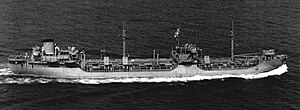
Containerization is a system of intermodal freight transport using intermodal containers. Containerization, also referred as container stuffing or container loading, is the process of unitization of cargoes in exports. Containerization is the predominant form of unitization of export cargoes, as opposed to other systems such as the barge system or palletization. The containers have standardized dimensions. They can be loaded and unloaded, stacked, transported efficiently over long distances, and transferred from one mode of transport to another—container ships, rail transport flatcars, and semi-trailer trucks—without being opened. The handling system is completely mechanized so that all handling is done with cranes and special forklift trucks. All containers are numbered and tracked using computerized systems.

An intermodal container, often called a shipping container, is a large standardized container designed and built for intermodal freight transport, meaning these containers can be used across different modes of transport – from ship to rail to truck – without unloading and reloading their cargo. Intermodal containers are primarily used to store and transport materials and products efficiently and securely in the global containerized intermodal freight transport system, but smaller numbers are in regional use as well. These containers are known under a number of names. Based on size alone, up to 95% of intermodal containers comply with ISO standards, and can officially be called ISO containers. Many other names are simply: container, cargo or freight container, shipping, sea or ocean container, container van or sea van, sea can or C can, or MILVAN, SEAVAN, or RO/RO. The also used term CONEX (Box) is technically incorrect carry-over usage of the name of an important predecessor of the international ISO containers, namely the much smaller prior steel CONEX boxes used by the U.S. Army.

A container ship is a cargo ship that carries all of its load in truck-size intermodal containers, in a technique called containerization. Container ships are a common means of commercial intermodal freight transport and now carry most seagoing non-bulk cargo.

Intermodal freight transport involves the transportation of freight in an intermodal container or vehicle, using multiple modes of transportation, without any handling of the freight itself when changing modes. The method reduces cargo handling, and so improves security, reduces damage and loss, and allows freight to be transported faster. Reduced costs over road trucking is the key benefit for inter-continental use. This may be offset by reduced timings for road transport over shorter distances.
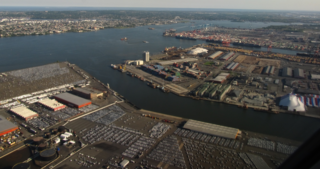
Port Newark–Elizabeth Marine Terminal, a major component of the Port of New York and New Jersey, is the principal container ship facility for goods entering and leaving the New York metropolitan area and the northeastern quadrant of North America. Located on Newark Bay, the facility is run by the Port Authority of New York and New Jersey. Its two components, Port Newark and the Elizabeth Marine Terminal sit side by side within the cities of Newark and Elizabeth, New Jersey, just east of the New Jersey Turnpike and Newark Liberty International Airport.
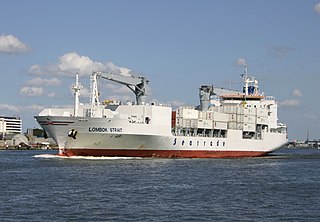
A reefer ship is a refrigerated cargo ship typically used to transport perishable cargo, which require temperature-controlled handling, such as fruits, meat, vegetables, dairy products, and similar items.

United States Lines was the trade name of an organization of the United States Shipping Board (USSB), Emergency Fleet Corporation (EFC) created to operate German liners seized by the United States in 1917. The ships were owned by the USSB and all finances of the line were controlled by the EFC. Among the notable ships of this period was Leviathan, a contender for largest ship in the world for a time.

SSMayaguez was a U.S.-flagged container ship that attained notoriety for its 12 May 1975 seizure by Khmer Rouge forces of Cambodia, which resulted in a confrontation with the United States at the close of the Vietnam War.

Malcolm Purcell McLean (November 14, 1913 – May 25, 2001; was an American businessman. He was a transport entrepreneur who invented the modern intermodal shipping container, which revolutionized transport and international trade in the second half of the twentieth century. Containerization led to a significant reduction in the cost of freight transportation by eliminating the need for repeated handling of individual pieces of cargo, and also improved reliability, reduced cargo theft, and cut inventory costs by shortening transit time. Containerization is credited as being one of the main drivers of globalization.

SeaLand, a division of the Maersk Group, is an American intra-regional container shipping company headquartered in Miramar, Florida with representation in 29 countries across the Americas. The company offers ocean and intermodal services using container ships, trucks, and rail serving customers between North and South America, Central America, and the Caribbean.

Đà Nẵng Port is a major port system located in Central Vietnam at the mouth of the Han River on the East Viet Nam Sea, in the city of Đà Nẵng. It is the third largest port system in Vietnam. Đà Nẵng Port lies at one end of the East–West Economic Corridor, an economic corridor connecting Vietnam with Laos, Thailand, and Burma. Vietnam National Shipping Lines (Vinalines) is the port's authority.

Seatrain Lines, officially the Over-Seas Shipping Company, was a shipping and transportation company conducting operations in the Americas and trans-Pacific regions. Seatrain Lines began intermodal freight transport in December 1928 by transporting entire loaded railroad freight cars between the United States and Cuba. The specially designed ship Seatrain, built in England, was followed in 1932 by two larger ships built in the United States and in 1939 by two additional ships. By the outbreak of World War II the company was operating five ships that became important in the war effort and basis for the design of fifty new ships for military use. A series of business setbacks amid the rise of containerized shipping left the company in perilous financial condition in the 1970s. Seatrain Lines shut down in 1981 after filing for bankruptcy.
Trailer Bridge, Inc. is a freight service company headquartered in Jacksonville, Florida. They offer international and domestic shipping with primary international calls to San Juan, Puerto Rico and Puerto Plata, Dominican Republic. They are one of the few companies offering 53-foot containers.

USS General C. C. Ballou (AP-157) was a General G. O. Squier-class transport ship for the U.S. Navy in World War II. She was named in honor of U.S. Army general Charles Clarendon Ballou. She was transferred to the U.S. Army as USAT General C. C. Ballou in 1946. On 1 March 1950, she was transferred to the Military Sea Transportation Service (MSTS) as USNS General C. C. Ballou (T-AP-157). She was later sold for commercial operation under several names before being scrapped some time after 1981.

USS General C. H. Muir (AP-142) was a General G. O. Squier-class transport ship for the U.S. Navy in World War II. The ship was crewed by the U.S. Coast Guard until decommissioning. She was named in honor of U.S. Army general Charles Henry Muir. She was transferred to the U.S. Army as USAT General C. H. Muir in 1946. On 1 March 1950 she was transferred to the Military Sea Transportation Service (MSTS) as USNS General C. H. Muir (T-AP-142). She was later sold for commercial operation under the names SS Chicago and SS San Juan, and was scrapped some time after 1985.

In shipping, break-bulk, breakbulk, or break bulk cargo, also called general cargo, refers to goods that are stowed on board ship in individually counted units. Traditionally, the large numbers of items are recorded on distinct bills of lading that list them by different commodities. This is in contrast to cargo stowed in modern intermodal containers as well as bulk cargo, which goes directly, unpackaged and in large quantities, into a ship's hold(s), measured by volume or weight.
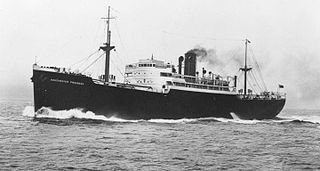
Manchester Liners was a cargo and passenger shipping company founded in 1898, based in Manchester, England. The line pioneered the regular passage of ocean-going vessels along the Manchester Ship Canal. Its main sphere of operation was the transatlantic shipping trade, but the company also operated services to the Mediterranean. All of the line's vessels were registered in the Port of Manchester, and many were lost to enemy action during the First and Second World Wars.
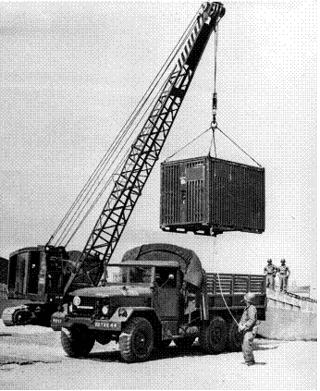
The CONEX box was a type of cargo container developed during the Korean War that was used to transport and store supplies during the Korean and Vietnam wars. It was reinvented by Malcom McLean to form the standard Intermodal shipping container that is used widely by container shipping companies today.

Maersk Line is a Danish international container shipping company and the largest operating subsidiary of the Maersk Group, a Danish business conglomerate. Founded in 1928, it is the world's largest container shipping company by both fleet size and cargo capacity, offering regular services to 374 ports in 116 countries. In 2019, it employed 83,625 people where 18,398 of which are vessel crew and the other 65,227 are processing and operations personnel in offices and ports.
GulfQuest/National Maritime Museum of the Gulf of Mexico opened on September 26, 2015, is a non-profit interactive maritime museum dedicated to the maritime heritage and culture of the Gulf of Mexico. The 120,000 square foot museum, located on the riverfront in downtown Mobile, Alabama, is designed to look as if it were a ship headed into Mobile Bay and the Gulf of Mexico. The museum features 90 interactive exhibits, simulators, theaters and artifact displays, complemented by artifacts and memorabilia displayed throughout "multiple decks" inside a full-sized replica of a container ship, displayed as if dockside. GulfQuest also features a museum store, a museum café and several event spaces.

